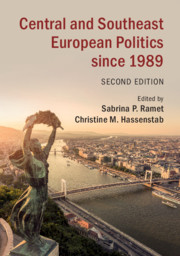Book contents
- Central and Southeast European Politics since 1989
- Central and Southeast European Politics since 1989
- Copyright page
- Dedication
- Contents
- Figures and Maps
- Tables
- Contributors
- Preface
- Glossary
- Guide to the Pronunciation of Central and Southeast European Words
- Additional material
- Part One Introduction
- Part Two Issues
- Part Three Central Europe
- 6 Poland since 1989: Muddling through, Wall to Wall
- 7 Building Democratic Values in the Czech Republic since 1989
- 8 Slovakia since 1989
- 9 Two Faces of Hungary
- Part Four Yugoslav Successor States
- Part Five Southeastern Europe
- Part Six Present and Future Challenges
- Index
9 - Two Faces of Hungary
From Democratization to Democratic Backsliding
from Part Three - Central Europe
Published online by Cambridge University Press: 16 September 2019
- Central and Southeast European Politics since 1989
- Central and Southeast European Politics since 1989
- Copyright page
- Dedication
- Contents
- Figures and Maps
- Tables
- Contributors
- Preface
- Glossary
- Guide to the Pronunciation of Central and Southeast European Words
- Additional material
- Part One Introduction
- Part Two Issues
- Part Three Central Europe
- 6 Poland since 1989: Muddling through, Wall to Wall
- 7 Building Democratic Values in the Czech Republic since 1989
- 8 Slovakia since 1989
- 9 Two Faces of Hungary
- Part Four Yugoslav Successor States
- Part Five Southeastern Europe
- Part Six Present and Future Challenges
- Index
Summary
This chapter looks at the last thirty years of political developments in Hungary as it explains how the democracy that was built after 1989 and was considered consolidated by many scholars has substantially eroded in the last ten years. We argue that the non-participatory or elitist nature of regime change and the new Hungarian democracy, the development of partitocracy, that is exercise of democracy exclusively through political parties, and the political elite’s never-ending demand for sacrifices from the population as an answer to economic problems led to public disillusionment with democracy. As a result, in 2010 voters gave Viktor Orbán and his government unchecked power to do as he wished. He used the power invested in him to consolidate the political, economic, and cultural dominance of his circle to the detriment of democratic values and institutions. We conclude by describing the characteristics of the externally constrained hybrid regime that has developed since 2010.
Keywords
- Type
- Chapter
- Information
- Central and Southeast European Politics since 1989 , pp. 221 - 248Publisher: Cambridge University PressPrint publication year: 2019
- 4
- Cited by

